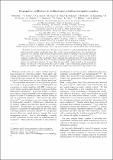Propagative oscillations in codirectional polariton waveguide couplers
Abstract
We report on novel exciton-polariton routing devices created to study and purposely guide light-matter particles in their condensate phase. In a codirectional coupling device, two waveguides are connected by a partially etched section that facilitates tunable coupling of the adjacent channels. This evanescent coupling of the two macroscopic wave functions in each waveguide reveals itself in real space oscillations of the condensate. This Josephson-like oscillation has only been observed in coupled polariton traps so far. Here, we report on a similar coupling behavior in a controllable, propagative waveguide-based design. By controlling the gap width, channel length, or propagation energy, the exit port of the polariton flow can be chosen. This codirectional polariton device is a passive and scalable coupler element that can serve in compact, next generation logic architectures.
Citation
Beierlein , J , Rozas , E , Egorov , O A , Klaas , M , Yulin , A , Suchomel , H , Harder , T H , Emmerling , M , Martín , M D , Shelykh , I A , Schneider , C , Peschel , U , Viña , L , Höfling , S & Klembt , S 2021 , ' Propagative oscillations in codirectional polariton waveguide couplers ' , Physical Review Letters , vol. 126 , no. 7 , 075302 . https://doi.org/10.1103/PhysRevLett.126.075302
Publication
Physical Review Letters
Status
Peer reviewed
ISSN
0031-9007Type
Journal article
Description
Funding: The Würzburg and Jena group acknowledges financial support within the DFG Projects No. SCHN1376/3-1, No. PE 523/18-1 and No. KL3124/2-1. The Würzburg Group acknowledges financial support by the German Research Foundation (DFG) under Germany’s Excellence Strategy–EXC2147 “ct.qmat” (Project No. 390858490) and is grateful for support by the state of Bavaria. S. H. also acknowledges support by the EPSRC Hybrid Polaritonics grant (EP/M025330/1). The Würzburg group wants to thank Hugo Flayac for inspiring discussions in the early stage of this work. The Madrid group acknowledges financial support of the Spanish MINECO Grant No. MAT2017-83722-R. E. R. acknowledges financial support from a Spanish Formación Personal Investigador Scholarship No. BES-2015-074708. I. A. S. acknowledges the financial support of the Icelandic Science Foundation (project Hybrid polaritonics). I. A. S. and A. Y. acknowledge the Ministry of Science and Higher Education of the Russian Federation (Megagrant No. 14.Y26.31.0015).Collections
Items in the St Andrews Research Repository are protected by copyright, with all rights reserved, unless otherwise indicated.

